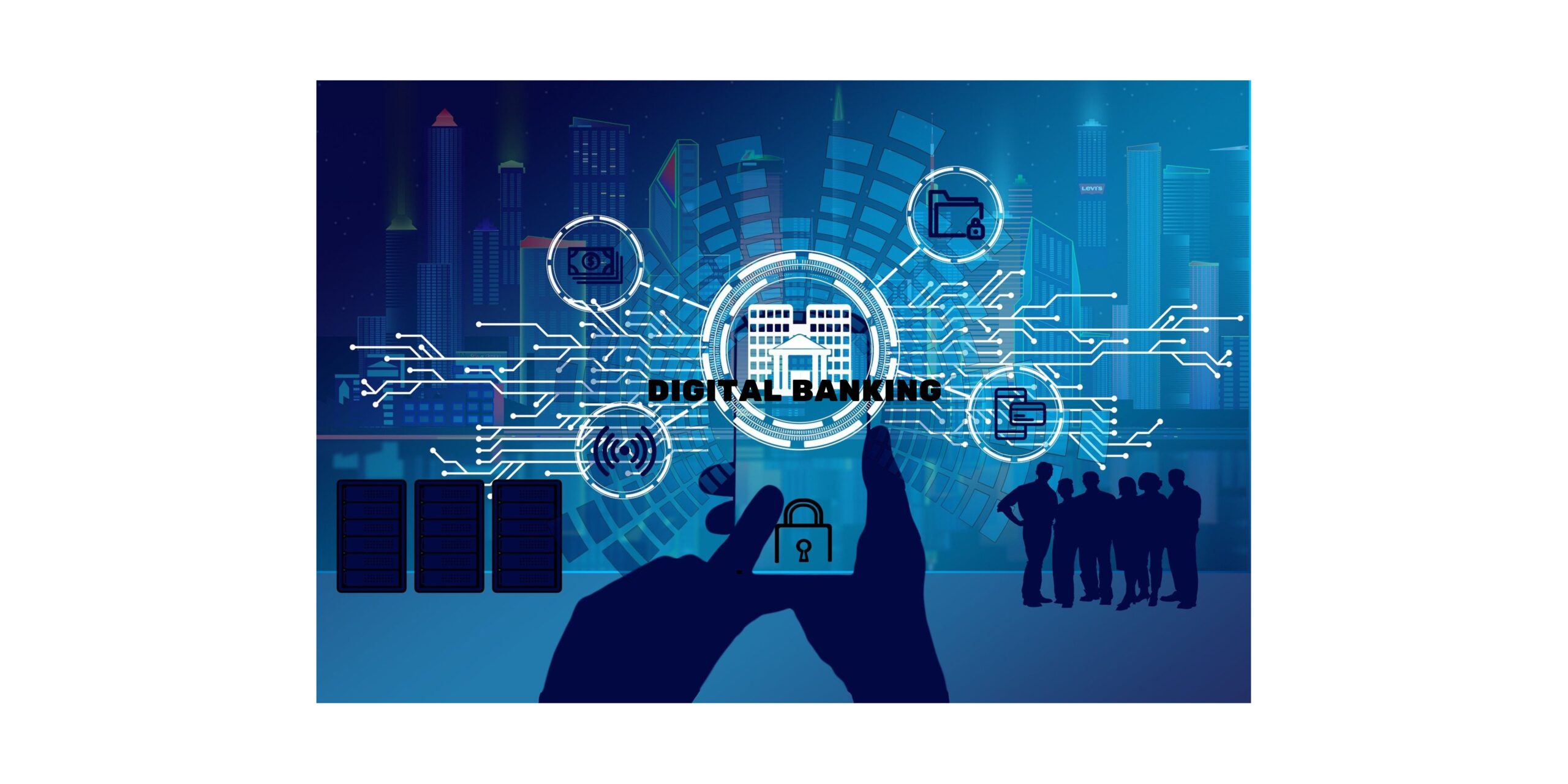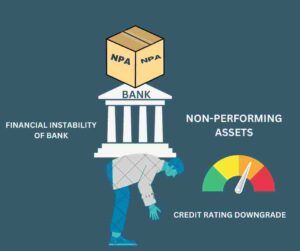
Introduction
In today’s interconnected world, digital technologies have transformed numerous industries, and banking is no exception. Digital banking, also known as online banking or e-banking, has emerged as a game-changer in the financial services sector
What is Digital Banking?
Digital banking, commonly referred to as online banking or e-banking, is the practice of conducting financial transactions and offering banking services using digital technology and electronic devices. It entails providing a range of banking services via digital platforms like mobile applications, websites, and other online platforms. Customers can use digital banking to access and manage their financial accounts, make transactions, and take advantage of a variety of financial services without physically going to a bank branch.
Rise of Digital Banking
Several significant elements that have shaped financial services and changed consumer expectations have fueled the growth of digital banking. These elements have had a big impact on the rapid growth and wide acceptance of digital banking services. Let’s examine the primary factors that have influenced the adoption of digital banking:
Technological advancements:
The adoption of digital banking has been greatly facilitated by technological improvements, notably those related to internet access, mobile devices, and digital infrastructure. Digital banking services are flourishing thanks to the widespread use of high-speed internet and the rising popularity of smartphones and other connected devices.
Changing Customer Behavior and Expectations:
As technology becomes more integrated into people’s daily lives, customers’ expectations and behaviors have changed significantly. In every area, including banking, they desire simplicity, swiftness, and individualized experiences. Digital banking platforms that meet these increasing client expectations have been widely adopted in response to the desire for anytime, anywhere access to financial services.
Mobile Lifestyle and On-the-Go Banking:
Due to the widespread use of mobile devices, people can now carry out a variety of jobs and stay connected when they are on the go. When it comes to financial services, customers today demand the same level of accessibility and convenience. Mobile banking applications, which give consumers access to banking functions right at their fingertips, have emerged as a major factor in the development of digital banking.
Cost and Time Efficiency:
Banks and customers can both save money and time with digital banking. Customers no longer need to physically visit bank locations, saving time and money on commuting. Banks save money and adopt a more ecologically friendly strategy as a result of the decrease in paper use brought about by digital transactions and electronic document management.
Enhanced Security and Trust:
The security of digital banking platforms has been strengthened thanks to the development of security technologies and strong encryption techniques. Banks have made significant investments in security methods and systems to safeguard client data and stop fraud and unauthorized access.
Support and Compliance with Regulations:
The potential advantages of digital banking have been acknowledged by governments and regulatory agencies, which have enacted legislation to support its expansion. Financial sector innovation and competitiveness have been facilitated by programs like open banking, which encourage secure data interchange between banks and authorized third parties.
Pandemic COVID-19 and Adapting Banking Practices:
The COVID-19 pandemic has sped up the adoption of online banking even more. Lockdowns and social isolation policies made it necessary for people and businesses to rely more on digital financial channels. As users looked for secure and frictionless ways to manage their accounts, the pandemic served as a stimulus for the adoption of digital banking services.
Increasing Financial Inclusion:
Digital banking has the potential to increase financial inclusion by giving underserved people, like those living in distant locations or without access to conventional banking infrastructure, access to banking services. By providing basic banking services and opening up financial transactions to people who were previously shut out of the traditional banking system, digital platforms can fill the gap.
Key Features and Services of Digital Banking
Customers can access a variety of features and services through digital banking that give them convenience, adaptability, and control over their financial affairs.
Account management:
Comprehensive account management features are offered by digital banking platforms. Customers get access to account balances, transaction histories, and information about their investments, loans, and deposits. With just a few clicks, they can also modify account preferences, set up notifications, and update personal information.
Online Payments and Transfers:
Customers can effortlessly make online payments and transfers thanks to digital banking. They can transfer money between their accounts, pay bills, and even set up periodic payments. Transactions become quicker and more effective as a result of the necessity for actual branch visits or writing checks being eliminated.
Mobile banking applications:
A crucial element of digital banking is mobile banking applications. Mobile devices provide a variety of functions and services. Customers can use their smartphones or tablets to access their accounts, perform transactions, deposit checks utilizing mobile check deposits, find ATMs, and get real-time notifications.
Personal Financial Management Tools:
Digital banking platforms often include personal financial management tools that assist users in tracking and analyzing their spending patterns, creating budgets, and keeping track of their financial objectives. These apps give customers financial health insights, classify transactions, and make suggestions on how to handle their money better.
Integration with Third-Party Services and Financial Technology (Fintech) Solutions:
Several digital banking platforms provide integration with third-party services and fintech products. Customers can now access additional services from within their digital banking interface, including investing platforms, loan comparison tools, and money management apps.
Loan Applications and Digital Lending:
The loan application procedure has been made simpler by digital banking. Online loan applications, electronic document submissions, and speedy loan approvals are all available to customers. Digital lending platforms use automation and data analytics to speed up loan underwriting and improve the efficiency of the lending process.
Investment and Wealth Management Services:
Digital banking platforms frequently offer investment and wealth management services. Customers can purchase and sell stocks, mutual funds, and other securities by logging into their investing accounts. Additionally, they might get tailored investment advice depending on their risk tolerance and financial objectives.
Card Management:
Customers who use digital banking may easily manage their debit and credit cards. To keep track of card usage and improve security, they can activate or deactivate cards, establish spending restrictions, and get transaction alerts.
Enhanced Security Measures:
To safeguard consumer data and transactions, digital banking systems put security first. To maintain the integrity and confidentiality of consumer data, they use strong security measures like encryption, secure authentication, and transaction monitoring.
Customer support and assistance
Customer support and assistance are provided through a variety of methods on digital banking platforms. Frequently Asked Questions (FAQs), customer care hotlines, and online chat assistance may all be included in this. Customers can navigate the digital banking experience with the help of interactive tutorials and instructional materials offered by some platforms.
Alerts and notifications:
Customers can configure alerts and notifications on digital banking platforms for particular account actions. These notifications can be set up for a variety of situations, including significant transactions, low-balance alerts, and payment due dates. Email, SMS, and the mobile banking app are all ways to get notifications.
Paperless Statements and Documents:
By offering electronic statements and documents, digital banking promotes a paperless approach. Customers can view and download critical financial papers, including account statements, tax returns, and other paperwork, digitally, which eliminates the need for actual paper records.
Benefits of Digital Banking for Customers
Some of the key advantages that customers can enjoy through digital banking are:
24/7 Accessibility and Convenience:
One of the significant benefits of digital banking is the availability of financial services wherever you are and whenever you need them. Customers can execute transactions, check account balances, and access services from the convenience of their homes or while on the go, 24 hours a day, 7 days a week.
Real-time account monitoring and control:
With online banking, users can keep an eye on the activity in their accounts right away. They can instantly watch their spending habits, view transactions as they happen, and check balances. Customers have more control over their funds thanks to this real-time visibility, which enables them to spot potential fraud and better manage their budgets.
Faster and more efficient Transactions:
Faster and more efficient transactions are made possible by digital banking, which does away with the necessity for in-person visits to bank locations and manual procedures. Customers can swiftly and effectively carry out operations like initiating foreign transfers, making online payments, and transferring money between accounts.
Seamless Banking Experience:
A seamless banking experience is provided through the seamless integration of digital banking into clients’ daily lives. Customers may quickly connect their bank accounts to various online services and platforms, like shopping websites and payment apps. Customers may easily manage their accounts while carrying out their usual activities, which enables quick and easy financial transactions.
Enhanced Customer Support and Service:
Customers can call customer service hotlines, use online chat help, or email their questions. The accessibility of digital channels guarantees quick and effective customer care, enabling clients to address problems or request assistance without having to physically visit a bank location.
Streamlined Account Opening and Loan Applications:
Customers can open new accounts more quickly and conveniently with digital banking, which streamlines the account opening procedure. The same ease of use is available for loan applications, allowing clients to apply online, submit required documentation electronically, and get loan approvals more quickly.
Enhanced Security and Fraud Protection:
To safeguard customer data and transactions, digital banking systems place a high priority on security measures. To protect against fraud and unauthorized access, they use powerful encryption, multi-factor authentication, and real-time transaction monitoring. Customers also get alerts and notifications for suspicious activity, which adds another level of protection and guarantees the reliability of their financial transactions.
Customized Product Recommendations:
To analyze consumer behavior and preferences, digital banking platforms use user data analytics, and machine learning algorithms. They can provide personalized product recommendations based on this research and the person’s financial requirements.
Financial Education and Resources:
Many online banking platforms include tools, articles, and educational materials to assist users in becoming more financially literate and making wiser decisions. These tools include information on a range of subjects, including budgeting, saving, and investment methods, enabling users to improve their financial literacy and realize their financial objectives.
Benefits of Digital Banking for Banks
Digital banking not only benefits customers but also provides significant advantages to banks and financial institutions.
Cost reduction and operational effectiveness:
Banks can drastically cut operational costs by using digital banking. Banks may streamline their operations, automate repetitive tasks, and do away with physical infrastructure and manual labor by switching to digital channels.
Expanded Customer Reach and Market Possibilities:
Because digital banking eliminates geographic restrictions, banks can increase their customer base outside of traditional branch networks. Digital channels also give banks the ability to target particular clientele groups or niche markets, expanding their market options and potential for expansion.
Data-Driven Insights and Analytics:
Digital banking platforms generate a vast amount of data related to customer behavior, transaction patterns, and preferences. Banks can leverage this data to gain valuable insights into customer needs, preferences, and market trends. By analyzing this data, banks can make informed business decisions, develop targeted marketing campaigns, and create personalized product offerings to meet customer demands effectively.
Enhanced Customer Engagement and Loyalty:
Digital banking platforms provide opportunities for banks to engage with customers in a more personalized and interactive manner. Through features such as personalized notifications, tailored product recommendations, and proactive customer service, banks can enhance customer satisfaction and loyalty.
Integration with Fintech Solutions and Collaboration:
Digital banking allows banks to collaborate with fintech companies and leverage their innovative solutions. Banks can integrate third-party fintech services, such as payment processors, robo-advisors, and financial planning tools, into their digital banking platforms. This collaboration enables banks to offer a wider range of services, improve customer experiences, and stay competitive in the evolving fintech landscape.
Streamlined Risk Management and Compliance:
Digital banking platforms provide advanced risk management and compliance capabilities. Banks can implement real-time transaction monitoring, fraud detection systems, and robust authentication methods to mitigate risks and ensure regulatory compliance. Digital systems facilitate the collection and analysis of compliance-related data, making it easier for banks to meet regulatory requirements and enhance their overall risk management practices.
Scalability and Operational Flexibility:
Scalability and operational flexibility are two features that digital banking platforms offer, enabling banks to meet the growing demands of their clientele. Banks can quickly expand their digital infrastructure to handle rising transaction volumes and customer numbers. Additionally, because digital banking systems are flexible, banks can roll out new features, services, and products more quickly, quickly responding to market changes and client demands.
Competitive Advantage and Differentiation:
In the current digital era, banks need to provide robust digital banking services to remain competitive. Banks may set themselves apart from their rivals by offering a seamless and complete digital banking experience. Customers are more likely to choose banks that have cutting-edge digital capabilities, making digital banking an important point of differentiation in the market.
Opportunities for Cross-Selling and Upselling:
Digital banking platforms allow banks to cross-sell and upsell their goods and services. Banks can find pertinent offerings and advertise them through tailored marketing campaigns by utilizing customer data and analytics. Addressing their changing financial needs, not only enhances revenue potential but also strengthens client relationships.
Digital Banking Offers Enhanced Operational Resilience:
Digital banking enables banks to keep providing services to consumers in the face of unforeseen disasters or disruptions. Digital channels guarantee continuous access to banking services even during events like natural catastrophes or pandemics, allowing banks to maintain business continuity and consumer satisfaction.
Regulatory Landscape for Digital Banking
The regulatory landscape for digital banking plays a crucial role in shaping the operations and growth of digital banking services. As digital banking continues to evolve and disrupt traditional banking models, regulators around the world are adapting to address the unique challenges and opportunities presented by this emerging sector.
Licensing and Authorization:
Regulators establish licensing and authorization requirements for entities providing digital banking services. These requirements ensure that digital banks meet certain standards in terms of capital adequacy, governance, risk management, and consumer protection. Licensing frameworks may vary across jurisdictions, with some countries introducing specific digital banking licenses, while others apply existing banking regulations to digital banking providers.
Security and Data Protection:
Regulators place significant emphasis on security and data protection measures in digital banking. They require banks to implement robust security protocols, encryption technologies, and authentication mechanisms to protect customer data and transactions. Regulations such as the General Data Protection Regulation (GDPR) in the European Union and data privacy laws in other jurisdictions mandate strict data protection practices and require customer consent for data usage.
Anti-Money Laundering (AML) and Know Your Customer (KYC):
To stop illegal activity, digital banking platforms must abide by anti-money laundering and know-your-customer regulations. The implementation of thorough AML and KYC procedures, including customer identification, transaction monitoring, and suspicious activity reporting, is mandated by regulators for digital banks.
Consumer Protection:
Banks must give clear and honest information about their products, charges, and terms of service, according to regulations. They require methods for handling consumer complaints, dispute settlement, and fair treatment of customers. Regulations also guarantee sufficient security and insurance of customer funds.
Cross-Border Operations:
Regulators set rules and specifications for digital banks operating internationally, such as licensing, adherence to local laws, data transfer rules, and collaboration with foreign regulators. To address the problems brought on by cross-border digital banking activity, regulators may work together internationally.
Open Banking and APIs:
Open banking efforts, which encourage secure and controlled data sharing between banks and approved third-party providers, have grown in popularity in many jurisdictions. To access client data through application programming interfaces (APIs) while maintaining data privacy and security, regulators set frameworks and standards for open banking. These rules support innovation, competition, and the creation of new financial services.
Cybersecurity and Operational Resilience:
Regulators focus on cybersecurity and operational resilience to protect the stability of digital banking systems. They set requirements for incident response, business continuity planning, and cyber security measures to safeguard against cyber threats and operational disruptions. Regulators may conduct regular audits and assessments to ensure banks’ adherence to cyber security standards and their ability to withstand cyberattacks.
Innovation and Sandbox Frameworks:
Recognizing the importance of fostering innovation in digital banking, regulators have introduced sandbox frameworks and innovation hubs. These initiatives provide a controlled environment for fintech startups and digital banks to test their innovative products and services while ensuring compliance with regulatory requirements. Sandbox frameworks allow regulators to closely monitor and support the development of new digital banking solutions.
Compliance Monitoring and Enforcement:
Regulators monitor digital banks’ compliance with regulatory requirements through audits, inspections, and reporting obligations. They have the authority to impose penalties, fines, or other enforcement actions for non-compliance. Regulators collaborate with other regulatory bodies, both domestically and internationally, to ensure consistent enforcement and information sharing to combat financial crimes and maintain market integrity.
Evolving Regulations and International Cooperation:
The regulatory landscape for digital banking continues to evolve to keep pace with technological advancements and changing market dynamics. Regulators actively collaborate with industry stakeholders, standard-setting bodies, and international organizations to address emerging risks and regulatory challenges. They participate in discussions and initiatives to harmonize regulations, promote cross-border cooperation, and facilitate innovation while ensuring stability and consumer protection.
Future Trends and Innovations in Digital Banking
The future of digital banking is poised to witness several exciting trends and innovations that will reshape the industry and redefine the way customers interact with their financial institutions. Let’s explore some of the key future trends in digital banking:
Artificial Intelligence (AI) and Machine Learning (ML):
These technologies will be crucial to improving the user experience of digital banking. To offer individualized customer support and assistance, banks will make use of Chabot and virtual assistants powered by AI. To provide individualized financial advice and product recommendations, ML algorithms will analyze enormous volumes of client data. Systems for detecting fraud powered by AI will also improve security and defend against online threats.
Expansion of Open Banking:
Open banking, which enables users to securely exchange their financial data with authorized third-party providers, will continue to gain popularity on a global scale. As banks work with fintech firms and developers to produce cutting-edge financial products and services, this trend will encourage innovation. Open banking APIs will make it easier to integrate various financial services seamlessly, providing customers with a comprehensive and unique banking experience.
Biometric Authentication:
Digital banking will increasingly use biometric identification techniques including voice recognition, facial recognition, and fingerprint recognition. There is no longer a need for conventional password-based authentication because of these technologies’ improved security and ease. Customers will have easy and secure access to their accounts and the ability to approve transactions using biometric identification.
Internet of Things (IoT) Integration:
As IoT devices expand; digital banking will be able to use IoT technologies to offer new banking experiences. Customers will have access to connected gadgets like smartwatches, voice assistants, and even smart home appliances to complete banking and payment transactions. Real-time data will be provided to banks by IoT-enabled devices, enabling more specialized financial services.
Voice Banking:
Voice-enabled banking services will become increasingly popular, driven by the growth of virtual assistants like Amazon’s Alexa, Google Assistant, and Apple’s Siri. Customers will be able to check account balances, make transactions, and access financial information using voice commands. Banks will invest in voice recognition technologies to provide seamless and secure voice banking experiences.
Enhanced Data Analytics:
To acquire a deeper understanding of client behavior, preferences, and financial demands, banks will use big data analytics. Banks will be able to offer proactive financial advice, individualized product recommendations, and predictive insights thanks to advanced data analytics tools. These data will aid banks in providing customized services, raising client satisfaction levels, and encouraging repeat business.
Blockchain and Crypto Currencies:
Blockchain technology will continue to revolutionize the financial industry, particularly in areas such as cross-border payments, smart contracts, and identity verification. Digital currencies and stablecoins may gain wider acceptance, with banks exploring the use of blockchain-based solutions for faster, more secure, and cost-effective transactions. Central bank digital currencies (CBDCs) will also be a focus of exploration and development.
Robotic Process Automation (RPA):
RPA automates back-office activities and repetitive procedures in digital banking, increasing effectiveness and lowering costs. Work like data entry, document processing, and compliance checks will be handled by software robots. This will increase productivity and customer satisfaction by allowing human resources to concentrate on more challenging and valuable tasks.
Personalized and Contextual services:
Digital banking will advance to give highly personalized and contextual services based on distinct consumer choices, behavior, and real-time financial demands. Banks will use client data and analytics to provide specialized financial advice, personalized offers, and recommendations for specific products. Customers will receive proactive notifications, reminders, and alerts pertinent to their financial goals and situations.
Augmented Reality (AR) and Virtual Reality (VR):
AR and VR technologies will transform the way customers engage with digital banking interfaces. Banks may leverage AR and VR to provide immersive and interactive banking experiences, such as virtual branch visits, 3D visualization of financial data, and virtual investment portfolio management. These technologies will enhance customer engagement and make banking more engaging and enjoyable.
Challenges and Risks of Digital Banking
While digital banking brings numerous benefits and opportunities, it also poses several challenges and risks that need to be addressed.
Cybersecurity Threats:
With the increasing reliance on digital channels and the interconnected nature of the banking ecosystem, cybersecurity threats are a major concern. Hackers and cybercriminals constantly target digital banking platforms to gain unauthorized access to sensitive customer data, commit identity theft, or initiate fraudulent transactions.
Data Privacy and Protection:
As the collection and processing of enormous volumes of client data occur in digital banking, maintaining data privacy and protection is critical. To secure client information from unauthorized access, abuse, or breaches, banks are required to adhere to data privacy laws and implement strict procedures.
Regulatory Compliance:
The regulatory framework for digital banking is complicated, and banks must abide by several rules and legislation that are unique to the countries in which they conduct business. It can be difficult to stay on top of constantly changing laws including those about consumer protection, knowing your customer (KYC), and anti-money laundering (AML). To ensure compliance and prevent fines, banks must build internal controls, invest in strong compliance frameworks, and keep track of legislative changes.
Technological Infrastructure and Reliability:
A strong and dependable technology infrastructure is essential for digital banking. High system availability, seamless digital channel integration, and uninterruptible access to banking services are all requirements that banks must uphold. Customers can become dissatisfied, lose faith, and reputations can be harmed as a result of technical failures, outages, or interruptions.
Digital Divide and Inclusion:
Although digital banking provides efficiency, accessibility, and convenience, it can also widen the digital divide. Digital gadgets, internet connectivity, and essential digital literacy abilities are not accessible to everyone equally. Reaching marginalized communities and achieving financial inclusion becomes difficult as a result.
Customer Education and Trust:
In digital banking, establishing and sustaining client trust is essential. Due to worries about security, privacy, or the unfamiliarity of digital channels, some clients could be reluctant to adopt digital banking. Banks must actively inform their clients about the security measures in place, the advantages of digital banking, and the precautions they may take to stay safe. Building trust and confidence in digital banking requires clear communication, openness, and strong customer service.
Customer Experience and Human Touch:
Despite the ease that digital banking offers, some consumers may still appreciate personalized help and human touch. By providing a seamless Omni channel experience that combines the effectiveness of digital channels with individualized customer service delivered by Chabot, virtual assistants, or specialized customer support teams, banks must find the proper balance.
Operational Resilience and Business Continuity:
To minimize the effects of disruptions and ensure continuous access to banking services, banks must have strong business continuity plans, disaster recovery strategies, and incident response processes in place. Addressing risks from cyber-attacks, natural disasters, system failures, or external dependencies is part of this.
Fraud and Financial Crime:
Phishing attacks, account takeovers, and identity theft are just a few of the frauds that can target digital banking networks. Banks must put in place sophisticated fraud detection and prevention systems, keep an eye on transactions for irregularities, and inform clients of typical fraud tactics. Fighting fraud and financial crime requires close cooperation with law enforcement agencies, intelligence sharing, and the implementation of effective internal controls.
Technological Obsolescence and Disruption:
The rapid pace of technological advancements means that banks must constantly innovate and adapt to stay competitive. Failing to embrace emerging technologies or being slow to respond to market trends can lead to obsolescence and loss of market share.
Final Takeaway
Even if digital banking offers numerous advantages, there are still potential risks and difficulties involved. In order to manage cyber security threats, ensure data privacy, comply with regulations, close the digital gap, foster consumer trust, and maintain operational resilience, banks must take a proactive approach. By solving these issues, banks can maximize the benefits of digital banking while reducing the risks involved and providing safe and client-focused financial services.







